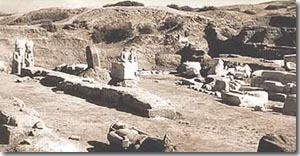| |
||||
|
||||
BUTO -- PE -- WADJET |
||||
 |
|
|||
During ancient times, Buto was the capital of the 6th nome. Just as Hierakonpolis, Buto continued to be an important center into the early dynasties of a united Egypt. Buto is probably shown on the Narmer Palette as a major Delta center. A tomb seal impression of 1st Dynasty king Qa'a (? -2890 BC) identifies a royal palace in Buto at that time which was still active during the 3rd Dynasty. Buto probably came about as the merger of two different centers. The Pyramid Text refers to the "kings of Lower Egypt who were in Pe". In some of the references, Pe is associated with Horus, the falcon god, so early on Horus was probably worshipped in both Lower and Upper Egypt. The text also references a place called Dep where the cobra goddess Wadjet was worshipped. Pe and Dep were apparently neighboring cities. Eventually, reflecting the two gods, the cities together were called Per-Wadjet and from this came the Greek name Buto. Hence, Wadjet is often referred to as Buto. Egyptian mythology also tells us that in the famous story of Osiris, Isis, Horus and Seth, after Osiris was killed by Seth, Isis hid Horus near the sacred town of Buto with the help of the goddess Hathor. The remains of Buto consist of three mounds, comprising two cities and a temple complex. The area was occupied into the Roman period, and was first identified as ancient Buto in 1888. The site was left mostly unexplored until the excavations and surveys in the 1960s. These initial excavations revealed Later Dynasties and Greco- Roman period remains, including cemeteries, houses, baths and temples. Predynastic remains were not discovered until excavations in the 1980s. Part of the discoveries included clay 'nails' and objects shaped liked tapering cones with a concave burnished end that resembles artifacts used in the Mesopotamian Sumerian Uruk culture to decorate temple facades. Also discovered were pot shards decorated with whitish stripes characteristic of contemporary Syrian pottery. Because of this evidence, some suggest that even during this period, earlier than 3,200 BC, the Delta Egyptians had contact with ancient Mesopotamia, perhaps through northern Syria. Other finds shows that Buto was probably occupied for at least 500 years during the Predynastic Period. Evidence from Buto suggests that early on Lower Egypt was influenced by the style of pottery found in Upper Egypt, and that later the Delta was enveloped by the Upper Egyptian culture. Such finding suggest that development in the Delta lagged behind that of Upper Egypt, or that politically-decentralized Lower Egypt was open to penetrataion and conquest by centralized Upper Egypt. Interestingly, while considerable ruins dating to predyanstic Egypt and Egypt's late period exist at Buto, there is little to suggest that Buto was any more then a small village during most of the Old, Middle and New Kingdom Periods. Yet tomb paintings elsewhere in Egypt suggest that Buto remained a capital of Lower Egypt. Some archaeologists believe that the Egyptians used Buto more as a symbolic capital for balance with Upper Egypt. However, it was surely a religious center, and Herodotus tells us that it was famous during Egypt's Persian period for its oracles. Excavations continue at Buto. But today there is really not much to see. As elsewhere in the Delta, monumental sites have been largely ruined by water. In fact, powerful pumps must be utilized for digs in the area because the predynastic levels are below the current water table.
|
||||
Home | Nile Valley | Dynasties | Wealth | Divinity | Temples | Hieroglyphs | Mysteries
|
||||